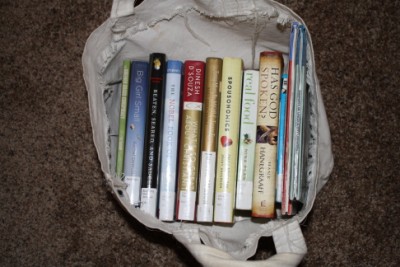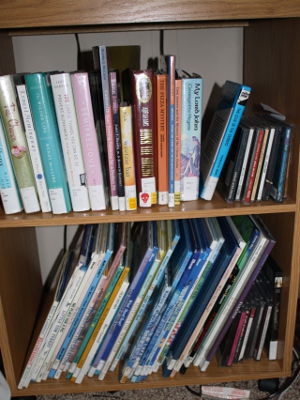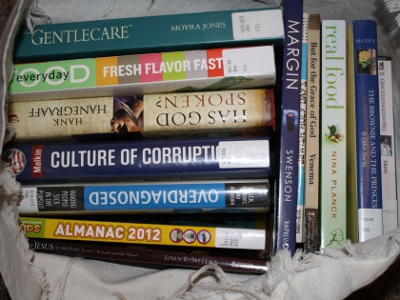I pulled the books off the shelf willy-nilly, eager for some Bible story action from the Dewey Decimal 222s. Like usual, I didn’t stop to look at titles or authors on any of them. After all, I’m going to read every book in that library eventually, right?
When I got home to discover that I had Ken and Mally Ham’s A is for Adam: The Gospel from Genesis in my stack (and saw how big the book was–a whomping 118 pages for a picture book!), my heart sunk a bit.
You see, I’m an adamant creationist–but a creationist of a different breed than the Hams. Most of my encounters with the Ham version of creation has involved bashing those of my opinion–accusing us of compromising Biblical authority, maligning God’s character, and undermining the gospel. Not exactly something that predisposes me to enjoying what he’s written.
What I found left me one part pleasantly surprised and one part frankly disappointed.
I found that the children’s picture book section of the volume focused primarily on the events of Genesis and saved its ire for evolution (rather than picking up the Old Earth-New Earth debate.) I appreciated this show of restraint in focusing on the less disputable matters in Genesis. While there were certainly some elements of the story that read into Scripture what Scripture may not actually be saying, the overall story reflected Orthodox Christian belief regarding creation with little to dispute. I found this pleasantly surprising.
What I did not find pleasant was the clunky grammar and contrived rhyme found throughout the story. I was ready to forgive “B is for Bible, a book God did give” as an awkward attempt to maintain meter. What I can’t forgive is “Like all of the animals, no man did they fear”, “To sleep God did put him, and when he awoke”, “H is for how very sly he did sound”, and so forth. The overuse of the emphatic “did”, generally in an inverted sentence, is deplorable. It is aesthetically awful, a rape of the English language. In this, the book was unequivocally disappointing.
I alluded a bit earlier to “the children’s picture book section” of this book. That’s because this volume is a multipurpose, 3-in-1 extravaganza. First, it contains a children’s picture book with the aforementioned despicable writing accompanied by full color cartoon-like illustrations. The second section consists of commentary and “student exercises” for each of the 26 rhymes found within the children’s picture book. Finally, the book is repeated with the illustrations offered in outline so that children can color the book.
The second section of the book showed little of the restraint that characterized the first. Among other things, the commentary asserts that we can confidently date both the creation of the world and the flood of Noah from the genealogies of Scripture, that Noah’s flood must have been a global flood, that animal death was necessarily a consequence of the fall, and that dinosaurs unequivocally coexisted with humans.
I’d have liked to have liked this picture book, with its mostly indisputable story of creation and its clear emphasis on the gospel as being God’s plan from the beginning. Unfortunately, the combination of bad writing in the picture book portion and the presentation of young earth perspectives as the only Biblically faithful way to interpret Scripture leaves me unable to recommend this book, even in part.
Rating:1 Star
Category:Nonfiction picture book
Synopsis: An A-B-C book detailing the events of creation as interpreted by Young Earth creationist Ham.
Recommendation: Great idea (for the picture book part). Awful writing. Wooden interpretation of Scripture. I don’t recommend it.
If it hadn’t have been too long, I would have subtitled this post “In which I come out of the closet.” I realize that many of my readers likely hold different views than I regarding creation. Please realize that my review of this book as an Old-Earth creationist is not, in any way, meant to be a criticism of New-Earth creationism as such. Rather, my criticism is for the refusal to accept alternate interpretations of the creation account (such as the Day-Age view, to which I subscribe) as orthodox. In other words, I understand and appreciate that others hold to a different interpretation of the events of creation than I do. I do not appreciate the tendency to make the age of the earth a point of doctrinal orthodoxy or to accuse those of a differing viewpoint of not caring about Scriptural faithfulness or gospel truth.



 Doctors H Gilbert Welch, Lisa M. Schwartz, and Steven Woloshin address this problem in their book Over-diagnosed: Making People Sick in the Pursuit of Health.
Doctors H Gilbert Welch, Lisa M. Schwartz, and Steven Woloshin address this problem in their book Over-diagnosed: Making People Sick in the Pursuit of Health. 


